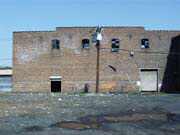“This vote is what we have been hoping for,” said John Gomez, president of the Jersey City Landmarks Conservancy, last week. “This will give people who want to develop the Whitlock Cordage site a chance to do so.”
Gomez was referring to the Jersey City Planning Board’s action Tuesday night in which they amended to the Morris Canal Redevelopment Plan to allow developers to save most of the historical Whitlock Cordage area.
The historic industrial area, located in the Lafayette section of Jersey City, dates back to the first Dutch settlers in Hudson County. It was developed in the late 1800s and a rope manufacturer, Whitlock Cordage, operated in the area until the late 1950s.
The amending of the redevelopment plan will allow Housing Trust of America, a Maryland-based development firm, to begin work on the rehabilitation of six out the eight buildings that currently occupy the location.
The news was not completely good, as it was announced that two of eight buildings would have to me demolished. According to project architect Bob Saraco, two structures behind the entrance to the Whitlock area, at 160 Lafayette Ave., would have to be torn down.
“We have examined both buildings,” Saraco informed the planning board Tuesday night. “It has been cost prohibitive to work with them.”
Meg Manely, a project manager with Housing Trust of America, said her firm plans to convert the Whitlock Cordage property into a mixed housing complex. The two buildings slated for destruction, Saraco stated, were unsuitable for development as housing.
“The first building, a three-story warehouse, has had significant damage to the roof and masonry,” explained Saraco. “The roof suffered from fire damage. The old masonry in the building had to be replaced with cement walls.”
According to Saraco, it would be too expensive to bring the building up to code.
Structural design problems are part of the problem with the second building scheduled for demolition, Saraco noted.
“The windows in the building are too few and placed too high on the wall for conversion to housing,” Saraco stated.
Michelle Alonso, principle planner with the Jersey City division of planning, said her department would work with developer to save the first building, which had been damaged by fire. Alonso added that restoration grants could help defray the costs of rehabilitating the building for the developers.
Gomez stated it would be desirable to save the building Alonso mentioned since it was likely to have been the site where the rope was manufactured in the late 1880s.
Manely informed the board that any development work done by Housing Trust of America would be mixed housing.
“The proportion would be 40 percent market rate housing,” said Manley. “Affordable housing would make up 60 percent of the project.”
At the time, Manley was unable to state what the composition of the units or their cost would be. She did state the affordable housing portion of the development would last for 40 years.
For the remaining six buildings, Saraco stated that one of the two smoke stacks attached to the main building would have to come down. Alonso asked that an effort be made to spare the smoke stack scheduled for destruction.
“We realize it was built later than the rest of the complex, in the 1930s,” said Alonso, adding that the smoke stack was still of historical significance.
Saraco added that other portions of the preserved buildings would be extended, including the main factory structure located near the Lafayette Avenue entrance. This building would have a space constructed on the side for a gym, Saraco stated. According to Manely, a portion of the development could possibly be utilized as artist housing.
The Planning Board made the change to the amendment for the developers by a vote of 6-0. In addition, the board recommended to the City Council that the Whitlock Cordage industrial complex put on the municipal list of historical landmarks.
With the designation by the City Council, according to Gomez, the new owner could then make application for state and federal landmark status.
“This would allow the owners of the property to qualify for tax credits and preservation grants,” Gomez said.
Emergency efforts to save the Whitlock Cordage began earlier in the month when a court order was issued for its demolition. The Whitlock property, once owned by developer Harvey Shapiro, who had planned to build a senior housing project in the area, was put up for sale when its owner filed for bankruptcy.
The complex was subject to a fire earlier in the year and its owner was cited by the city for code violations.
Manley said that when the sale of the property is concluded, work on the housing development would get started in late November.
